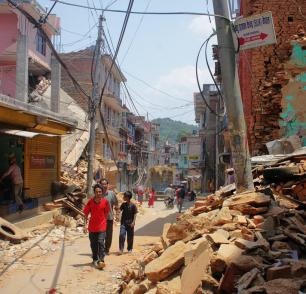Covering Trauma: Six Tips for Protecting Your Mental Health

CC-licensed by Flickr via UN Migration Agency (IOM)
Twelve years ago, I didn’t know how impacted I was by Nepal’s civil war and Maoist insurgency. For a year, I had to pore over raw footage of the aftermath of the war in post-production. After six months, I started dreaming scenes from the war. The same thing happened in 2015 after spending months producing numerous stories on the April earthquake in Nepal.
Amantha Perera, the Asia-Pacific coordinator at the Dart Center, explained this condition is known as "vicarious trauma." It's caused by working with victims of trauma or, in the case of journalists, covering traumatic events. While many of the symptoms are similar to the more commonly known post-traumatic stress disorder, many people don’t know vicarious trauma, also known as compassion fatigue, exists. But traumatic incidents can have psychological impacts on subjects, audiences and journalists alike.
The following techniques may help journalists build own resiliency and learn how to report sensibly on trauma-related issues:
1. Remember the importance of telling the story
When Narendra Shrestha, a Nepalese photojournalist, was covering a 2017 flood in the southern plains of Nepal, he photographed an incident in which an eight-year-old boy died of pneumonia after his village flooded. The pictures disturbed Shrestha, and he balked at publishing them online. But he realized he may regret not telling this important story. After he posted the story online, the story went viral and was later carried by international media outlets. “Our job is isn’t always luxurious," Shrestha said. "Sometimes, we have to face the ugliest situations.”
2. If a story becomes too overwhelming, take a break or give the story to someone else
Shrestha felt overwhelmed covering earthquake stories for a prolonged period of time. To get away from earthquake survivors’ heart-wrenching stories, he went overseas for a different assignment. “It was sort of a a way to let me forget the trauma,” he said.
3. Camera people and photographers should allow privacy during interviews
When reporters interview trauma victims, the camera persons and photographers should allow the reporter and interviewee to establish a rapport. Victims may not want to open up in the presence of photographers or videographers. To enable the reporter to build trust and not impact the conversation, videographers and photographers should put their cameras down and allow conversation to flow before getting consent and resuming filming and shooting pictures.
4. Don’t sensationalize traumatic events
Perera stressed journalists should not fall victim to the old and flawed adage — if it bleeds, it leads. The shock or horror factor is not what should guide news judgment.
5. Don’t publish stories until they are fact-checked
Publishing fake or incorrect data and information, especially regarding the number of dead, can diminish trust and credibility in media. “We barely think of the pain the family of an accident victim has to bear when we incorrectly increase the number of deaths reported in a competition to see who can break the news first,” said Dilip Thapa Magar, a Kathmandu-based freelance television reporter.
6. Share your experience
Share and review your experience of covering trauma with your newsroom; it could help others thoughtfully cover incidents in the future. “For journalists to feel safe and able to do trauma reporting, they need to discuss issues openly and know colleagues will be there to help,” Perera said.
The post originally appeared on the International Journalists’ Network and is published here with permission. IJNet delivers the latest on global media innovation, news apps and tools, training opportunities and expert advice for professional and citizen journalists worldwide. IJNet is produced by the International Center for Journalists in seven languages - Arabic, Chinese, English, Persian, Portuguese, Russian and Spanish. Subscribe to IJNet’s free, weekly newsletter. You can also follow IJNet on Twitter or like IJNet on Facebook.